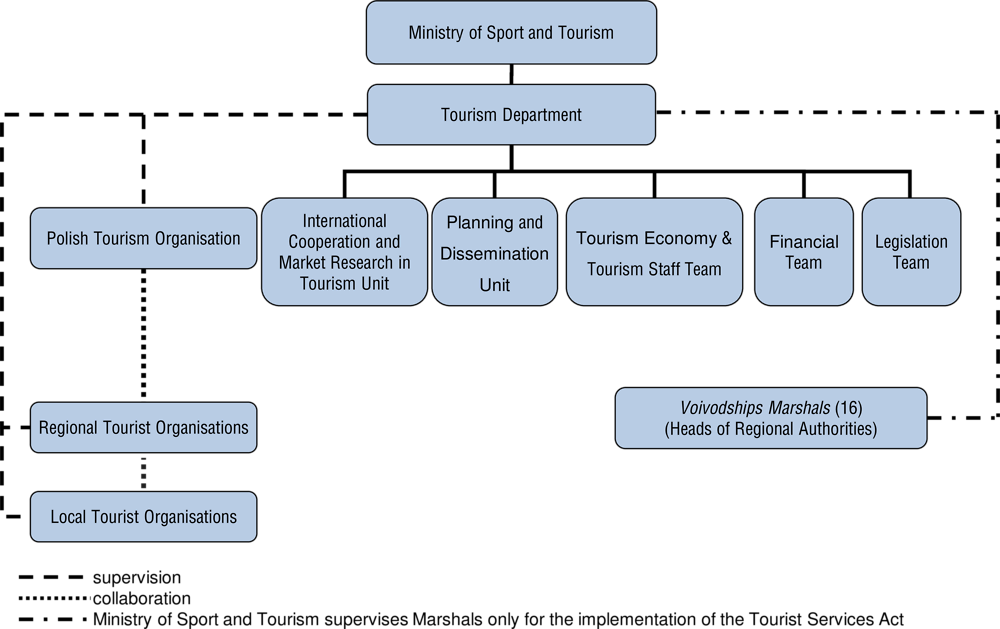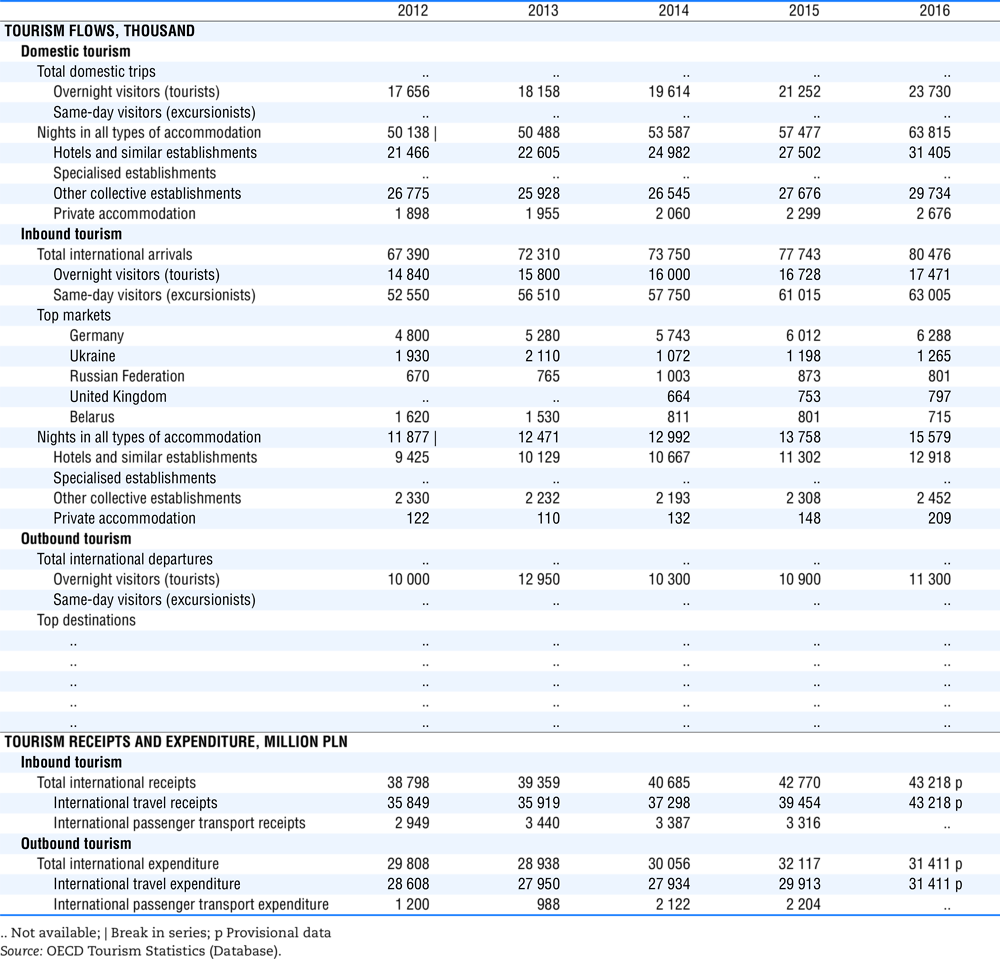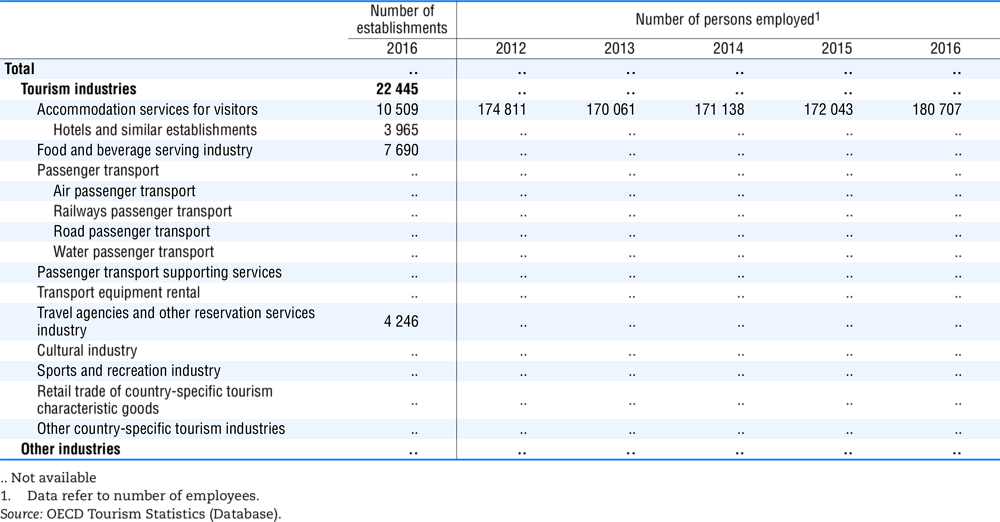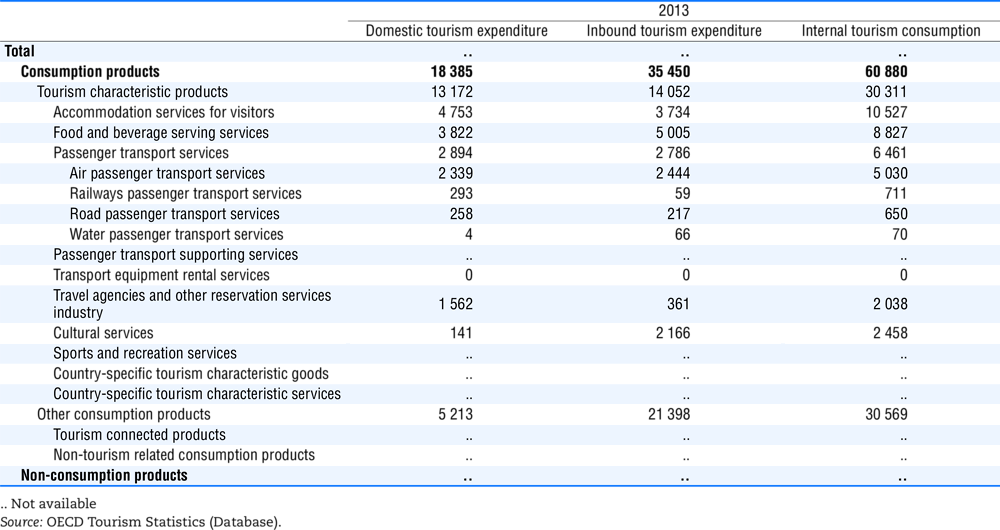Poland
Tourism in the economy
The total value of the tourism economy in Poland was estimated at PLN 110.3 billion in 2016, a rise of 7.7% over 2015. This equates to a contribution of 6% to Poland’s GDP.
International visitor arrivals increased by 3.6% to 80.5 million in 2016. This includes 17.5 million tourist arrivals, a rise of 4.8% over 2015 and a new record for Poland since joining the Europe’s Schengen Area in 2007. Germany remains the largest source market, accounting for 36% of international tourist arrivals. International tourism receipts increased by 6.9% to reach PLN 57.6 billion in 2016, accounting for 6% of total export earnings.
The number of domestic trips totalled 43.5 million in 2016, a rise of around 9% on 2015. A majority of domestic trips were short visits of 2-4 days (60.9%). Revenues from domestic tourism increased by 17.8% to PLN 21.8 billion in 2016.
In 2015, 252 300 people were employed in the accommodation and catering sector, compared with 248 700 in 2014.
Tourism governance and funding
The Ministry of Sport and Tourism (the “Ministry”) is responsible for tourism-related matters, including management and regulation of tourism in Poland and the Polish Tourism Organisation (POT).
The main activities of POT include: the promotion of Poland as an attractive tourism destination; operation and development of domestic and international tourism information systems; and the initiation, assessment and support for plans to develop, renovate or rejuvenate tourist infrastructure. POT has 14 international offices in important current and future source markets.
Many aspects of national policy that affect tourism reside outside the responsibility of the Ministry, while many tasks affecting tourism development fall within the remit of regional and local governments. POT also co-operates with regional and local tourism organisations and autonomous bodies involved in tourism promotion and development at a regional and local level, based on a partnership of equal rights.
At sub-national level, the primary role in tourism development is played by regional governments (Voivodships) and local governments (Poviats at the county level and Gminas at the municipality level). Local or regional tasks fall into two groups: i) public sector tasks that are not allocated elsewhere by relevant legislation, and ii) tasks commissioned by the National Government Administration.
Commissioned tasks include supervision, registration, licensing and compliance with various standards of travel agents and tour operators, mountain guides, and also the classification of hotel facilities.
Municipalities are responsible for keeping registers of campsites and non-hotel accommodation service providers, inspecting accommodation facilities, and applying sanctions if necessary.

Source: OECD, adapted from the Ministry of Sport and Tourism, 2018.
In 2016, the budget of the National Tourism Administration amounted to PLN 50.3 million, including PLN 39.4 million for the Polish Tourist Organisation. In addition, specific tourism sector projects were supported by EU structural funds during 2014-20. The above figures do not include regional and local government budgets, which together accounted for additional spending of PLN 198 million on tourism in 2016.
Tourism policies and programmes
The main objective of Poland’s national policy is to strengthen the development of competitive and innovative tourism through the support of enterprises, organisations, institutions and initiatives in the tourism sector, while respecting the principles of sustainable development.
This comprehensive approach is focused on the following priority areas:
-
Competitive and innovative tourism,
-
Modern tourism management systems,
-
Skilled workforce for the tourism industry,
-
Contribution of tourism to regional and local development, enhancing social and economic cohesion and improving quality of life.
The “Programme for Tourism Development until 2020” sets out operational objectives and specific tasks for the sector, identifying those responsible for coordination, delivery and funding.
One of the main projects developed to implement the programme and commercialise the Polish tourist brand is the House of Polish Tourism Territorial Brands (Dom Polskich Turystycznych Marek Terytorialnych). The House will coordinate tourism policies by creating systematic and comprehensive solutions. It will provide organisational, financial and legal tools for integration, coordination, commercialisation and internationalisation of Polish tourism products that are based on the cultural and natural potential of the country. This creates an opportunity for rural areas to be better integrated within the development process of the country, to ensure that they provide the necessary public goods, and are marketed as unique landscapes with cultural and natural assets.
The House of Polish Tourism Territorial Brands is among the strategic projects to be implemented under the Responsible Development Strategy adopted by the Council of Ministers in February 2017.
Increased interest in domestic tourism and short break holidays inspired the Polish Ministry of Sport and Tourism to introduce a new marketing campaign in 2016 called “Poland See More – Weekend at half price”. Over 400 partners, including mines, museums, theme parks, zoos, castles, palaces, theatres, hotels, hostels, and spa resorts, developed special half-price offers for a chosen weekend. Both public and private sectors were involved in this new form of regional co-operation which marks a new approach to promoting both acclaimed and lesser-known tourist attractions. The first campaign led to over 60 000 tourists taking advantage of the special offers. The Polish Tourist Organisation went on to arrange a second weekend, which saw over 77 500 people choosing to benefit from the offers. Similar weekends are now scheduled to take place twice a year.



